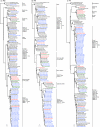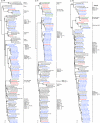Establishment of an H6N2 influenza virus lineage in domestic ducks in southern China
- PMID: 20463062
- PMCID: PMC2898240
- DOI: 10.1128/JVI.00256-10
Establishment of an H6N2 influenza virus lineage in domestic ducks in southern China
Abstract
Multiple reassortment events between different subtypes of endemic avian influenza viruses have increased the genomic diversity of influenza viruses circulating in poultry in southern China. Gene exchange from the natural gene pool to poultry has contributed to this increase in genetic diversity. However, the role of domestic ducks as an interface between the natural gene pool and terrestrial poultry in the influenza virus ecosystem has not been fully characterized. Here we phylogenetically and antigenically analyzed 170 H6 viruses isolated from domestic ducks from 2000 to 2005 in southern China, which contains the largest population of domestic ducks in the world. Three distinct hemagglutinin lineages were identified. Group I contained the majority of isolates with a single internal gene complex and was endemic in domestic ducks in Guangdong from the late 1990s onward. Group II was derived from reassortment events in which the surface genes of group I viruses were replaced with novel H6 and N2 genes. Group III represented H6 viruses that undergo frequent reassortment with multiple virus subtypes from the natural gene pool. Surprisingly, H6 viruses endemic in domestic ducks and terrestrial poultry seldom reassort, but gene exchanges between viruses from domestic ducks and migratory ducks occurred throughout the surveillance period. These findings suggest that domestic ducks in southern China mediate the interaction of viruses between different gene pools and facilitate the generation of novel influenza virus variants circulating in poultry.
Figures



References
-
- Chen, H., G. J. D. Smith, S. Y. Zhang, K. Qin, J. Wang, K. S. Li, R. G. Webster, J. S. M. Peiris, and Y. Guan. 2005. Avian flu: H5N1 virus outbreak in migratory waterfowl. Nature 436:191-192. - PubMed
-
- Cheung, C. L., D. Vijaykrishna, G. J. D. Smith, X. H. Fan, J. X. Zhang, J. Bahl, L. Duan, K. Huang, H. Tai, J. Wang, L. L. Poon, J. S. M. Peiris, H. Chen, and Y. Guan. 2007. Establishment of influenza A virus (H6N1) in minor poultry species in southern China. J. Virol. 81:10402-10412. - PMC - PubMed
-
- Chin, P. S., E. Hoffmann, R. Webby, R. G. Webster, Y. Guan, M. Peiris, and K. F. Shortridge. 2002. Molecular evolution of H6 influenza viruses from poultry in southeastern China: prevalence of H6N1 influenza viruses possessing seven A/Hong Kong/156/97 (H5N1)-like genes in poultry. J. Virol. 76:507-516. - PMC - PubMed
-
- Duan, L., J. Bahl, G. J. D. Smith, J. Wang, D. Vijaykrishna, L. J. Zhang, J. X. Zhang, K. S. Li, X. H. Fan, C. L. Cheung, K. Huang, L. L. Poon, K. F. Shortridge, R. G. Webster, J. S. M. Peiris, H. Chen, and Y. Guan. 2008. The development and genetic diversity of H5N1 influenza virus in China, 1996-2006. Virology 380:243-254. - PMC - PubMed
Publication types
MeSH terms
Substances
Grants and funding
LinkOut - more resources
Full Text Sources
Medical

